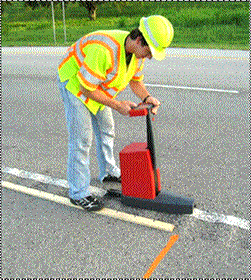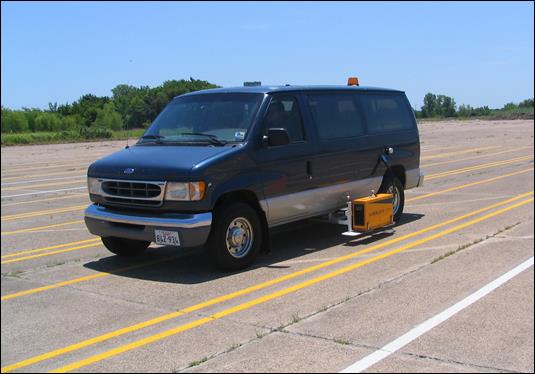U.S. Department of Transportation
Federal Highway Administration
1200 New Jersey Avenue, SE
Washington, DC 20590
202-366-4000
In general, there are two ways that pavement marking retroreflectivity can be measured in the field: with hand-held instruments or with mobile instruments. Hand-held instruments require the measurement device to be set on the pavement marking. Mobile instruments are attached to a vehicle and measure the pavement marking retroreflectivity as the instrumented vehicles passes by at typical roadway speeds. Both techniques provide objective retroreflectivity values that can be used in direct comparison to the minimum retroreflectivity levels. The use of the measurement method as an exclusive process to maintain pavement marking retroreflectivity has not historically appealed to agencies, as will be discussed in the following sections. However, when combined with another method, the measured pavement marking retroreflectivity method adds an element of objectivity to the overall maintenance program. This combination of methods may maximize maintenance budgets and provide additional protection from tort claims.
There are several commercially available hand-held retroreflectometers that can be used to measure pavement marking retroreflectivity. While both the hand-held measurement instruments and the mobile measurement instruments provide similar results related to measurement bias, repeatability, and reproducibility,(20) using hand-held instruments can be time consuming if there are many roadways with miles of pavement markings to be sampled. Mobile pavement marking retroreflectivity measurement devices offer flexibility and speed-up the measurement process. However, mobile measurement devices necessitate a relatively high level of capital investment for those agencies interested in purchasing their own. Alternatively, there are companies that specialize in pavement marking measuring services using both hand-held and mobile measurement devices.
The minimum retroreflectivity levels specified in the MUTCD are specified at what is called 30-meter geometry.((20) Essentially, retroreflective measurements made under 30-meter geometry simulate the retroreflective performance of the pavement marking at a distance 30 meters in front of the vehicle (using entrance and observation angles of 88.76 and 1.05 degrees, respectively). Measurements of pavement marking retroreflectivity that are used to determine compliance with the MUTCD minimum levels must be made with instruments that are designed to measure retroreflectivity at 30-meter geometry.
When the pavement marking measurement method is implemented, many ask how many readings are needed. For handheld retroreflectometer measurements, ASTM has developed a standardized practice, ASTM D7585 / D7585M-10, Standard Practice for Evaluating Retroreflective Pavement Markings Using Portable Hand-Operated Instruments.(11)) Currently, there is not a national standard for mobile retroreflectometer measurements.
Pavement marking retroreflectivity measurements are typically averaged, and the average value is compared to a threshold. More elaborate mathematical processes can also be used, such as considering the variability in the measurements, or determining the percentage of the measurements above some secondary threshold. For yellow pavement markings on centerlines, it is common to measure the retroreflectivity in both directions and use the lowest results.
More information about retroreflectometers can be found on the following Web sites:
Note that the FHWA does not endorse the use of any specific instrument or service provider. While the above list is, to the authors' best knowledge, complete as of the date of publication, other instruments and services may be available or may become available in the future. Each agency is encouraged to review the specifications for the various instruments and determine for themselves which instrument is most appropriate for their application.
Measuring retroreflectivity using a hand-held instrument should be performed in safe conditions with the appropriate traffic control. Measuring retroreflectivity using a mobile instrument provides relief from the need for traffic control. Using either type of instrument, the measurements must be made under dry conditions (pavement marking retroreflectivity can be measured under wet recovery and wet continuous conditions, but the minimum maintenance levels in the MUTCD pertain only to dry conditions). It is important to maintain a record of the measurements, when they were made, and other related information as deemed appropriate. If the measured retroreflectivity value is less than the minimum level, the markings should be replaced.

Figure 4. Typical Hand-Held Pavement Marking
Retroreflectivity Measurement Device
Pavement marking retroreflectometers come in two basic types: handheld and mobile. Examples of both types of retroreflectometers are shown in Figures 4 and 5. Handheld retroreflectometers are much less expensive than mobile units, are much easier to use, and require less training. However, handheld units are inconvenient when a large number of measurements are required or when measuring on roads with high-traffic volumes. There are also safety issues related to the use of handheld units as workers are often exposed to traffic while measuring the retroreflectivity of a marking. Taking handheld measurements often requires lane closures, increasing delay to motorists.

Figure 5. Typical Mobile Pavement Marking Retroreflectivity Measurement Device
Mobile units on the other hand are much more expensive than handheld units and require a significant amount of training and maintenance. However, mobile retroreflectometers produce a very large number of measurements and allow for measurements to be taken at highway speeds without exposure of personnel to traffic or lane closures. Some state transportation agencies own mobile retroreflectometers, although most agencies hire qualified contractors to perform mobile retroreflectivity measurements.
Some States such as North Carolina and Michigan have been systematically measuring pavement marking retroreflectivity for many years as part of their pavement marking management program. Other States such as Iowa and Wisconsin use hand-held pavement marking retroreflectivity devices to monitor pavement marking retroreflectivity.
This method uses measured retroreflectivity as the basis for the decision of whether or not pavement markings meet the required minimum level of retroreflectivity. The measured retroreflectivity values are compared to the minimum retroreflectivity levels specified in the MUTCD. Pavement markings should be scheduled for replacement if the measured retroreflectivity is at or very close to the minimum required level. This method provides the most direct comparison of in-service pavement marking retroreflectivity relative to the minimum maintained retroreflectivity levels.
Retroreflectivity measurements can be made during the day. Measurements provide the most direct means of monitoring pavement marking retroreflectivity levels and reduce the uncertainty that exist in other methods. However, a limit must be established on how close a pavement marking's retroreflectivity levels can be to the required minimum levels before the markings must be replaced. Measurement uncertainty and the variance between the retroreflectivity at the prescribed measurement geometry versus the retroreflectivity at the actual observation geometry may result in a pavement marking that meets the minimum requirements but does not meet the needs of the driver, and vice versa.
The main disadvantages of using this method is that measuring pavement markings can be time consuming and cost prohibitive, depending on the amount of pavement markings to be measured and the measurement technique. Measured retroreflectivity may be best used to support one of the other methods.
Another disadvantage i+s that using the retroreflectivity of the pavement marking as the only indicator of whether or not a re-marking should be initiated may result in other attributes of the marking's overall appearance being neglected. Other factors should be considered, including the daytime and nighttime color, the presence of the marking material, and the uniformity of the nighttime appearance. Finally, agencies need access to the measurement devices and trained personnel to use this method (or the measurement services of a third party).
The measurement bias, repeatability, and reproducibility limits of retroreflectivity measurements are also an important consideration when using measurements to determine compliance with a threshold such as the MUTCD minimum pavement marking retroreflectivity levels. ASTM has recently updated the repeatability and reproducibility limits for pavement marking retroreflectivity measured with a 30-m geometry hand-held instrument (see ASTM E1710-11).(21)
11ASTM International, ASTM D7585 / D7585M-10, Standard Practice for Evaluating Retroreflective Pavement Markings Using Portable Hand-Operated Instruments (West Conshohocken, PA: 2010). Available at: www.astm.org
20Highway Innovation Technology Evaluation Center (HITEC), Summary of Evaluation Findings for 30-meter Handheld and Mobile Pavement Marking Retroreflectometers, Report 40525 (2001).;
21 ASTM International, ASTM E1710-11, Standard Test Method for Measurement of Retroreflective Pavement Marking Materials with CEN-Prescribed Geometry Using a Portable Retroreflectometer (West Conshohocken, PA: ASTM, 2011). Available at: www.astm.org.
22 Migletz, J., J. L. Graham, D.W. Harwood, and K.M. Bauer, "Service Life of Durable Pavement Markings," Transportation Research Record: Journal of the Transportation Research Board, 1749 (2001).
| < Previous | Table of Contents | Next > |
